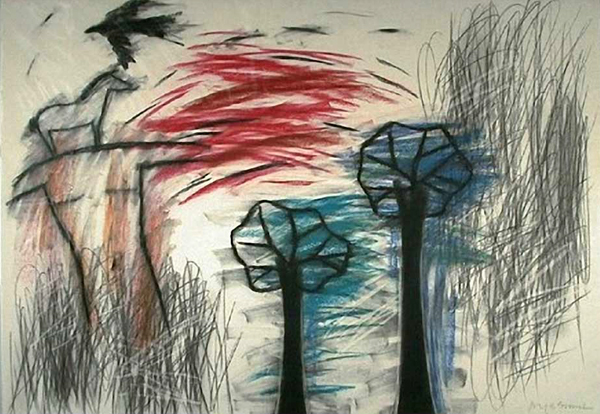
Jaune Quick to See Smith: Environment, Friend or Foe?
At the very back of the Georgia O’Keeffe Museum are two small rooms of works by Jaune Quick-to-See Smith, a New Mexico-based artist enrolled as a Salish member of the Confederated Salish and Kootenai Nation (Montana). Smith’s Native American heritage makes her more American than the American modernists, which she would be the first to mention. One of Smith’s previous pieces asks the viewer to “Celebrate 40,000 years of American Art,” beginning with the Native Americans, whose surviving petroglyphs remind us of a trampled society often glorified for its exotic mysticism. This overlooked past features prominently in Smith’s work at the O’Keeffe in “Landscapes of an American Modernist.”
New Mexico boasts a Lascaux equivalent just west of Albuquerque that informed Smith’s Petroglyph Park series. The Courthouse Steps (1987) was painted in response to the “preservation emergency” on September 4, 1987, when a landowner forcibly removed a boulder covered in petroglyphs from the formerly contested lands of Petroglyph National Monument. He brazenly “delivered” the rock to the courthouse steps. Obviously no friend to (Native) American history, his was a putative act of protest over the legality preventing him from developing “his” land.
Smith reports this incident with an image painted in rosy hues. Caught in a cultural exchange of signs in which no less than Jackson Pollock’s She-Wolf background might be present, Courthouse Steps lures with its warm pinks, emotive brush strokes, and vaguely familiar glyphs. “My work has layered meanings, so you can see many different levels within one single work,” Smith says, “I like to bring the viewer in with a seductive texture, a beautiful drawing, and then let them have one of the messages.”

Considering Smith’s brazen message, the viewer mulls over cross-hatching, notices staircases rising or descending, painted in black-and-white. There’s a sun, a moon, and then, at the very top, a cluster of pink high-rise buildings perched in the heavens. Smith creates a nostalgic place of abstract strokes and then those pink buildings expose a vague problem: Environment, friend or foe? Is this land my land, your land, or sacred land?
In a small work on paper entitled Tree Planter (1991), basic imagery is interceded by text. The surface is clean, with little overlapping, and like most of her work this landscape lacks the perspectival horizon. Just off center lies a silhouetted human form cut out from an assumed magazine page, originally filled with flowers. A constellation of collaged text reads: “Give me all the facts,” “environment,” “peace,” and stenciled in larger letters, “AIR.” If Smith is a reporter, Tree Planter reads like a pre-teen sketchbook that dislodges magazines’ glossy perfection into an assay at personal identity. The text culturally scrutinizes a palimpsest out of America’s dirty air and airbrush tendencies. We have to assume that the tree planter may be a phantom, already dead. His flattened shape looks like the chalk outline marking where a body fell in a crime scene.
As I stood wondering if Smith’s alluring paintings don’t first seduce you then smack you with the evasive promise that you can get close to something real, the Texas-accented women around me began chirping about the “petro-glyphs,” as if confusing a trip to the museum with a tourist brochure promising “Real, eco, New Mexico.”

It sadly wasn’t much better when I asked the docent about the relationship between Smith and O’Keeffe. His canned answer: that both artists were female and landscape artists working in New Mexico. This left me bewildered. For while O’Keeffe’s ladders appear to poke into a mystical starry beyond, Smith’s painted badmintons ask us to look more deeply at our relationship to environment, even as our romance with its myths pings back at us.
Feature Image: Jaune Quick-to-See Smith, The Environment: Trees are Burning, pastel on paper, 30 x 42 inches, 1991

This is a great post, I’m doing Jaune Quick to See Smith as my artist for my artist reproduction in school it really helped my understand why she did this painting and a lot more about her. Thanks